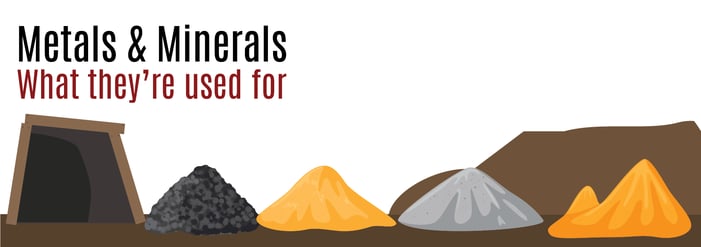In this week’s blog, we’re going to explore some of the most common minerals and metals that are mined and what they are most used for.
We rely on the mining industry to gather and collect a variety of different minerals to be used for many different purposes. Some minerals are rarer than others, so when the demand increases, and the supply can’t maintain demand, this increases the value. However, this can change at any point, depending on what mineral is most in demand.
Minerals and metals are extremely important, and we rely on them in our everyday lives, whether that’s in the vitamins we take, or the electrical devices we use. Without them, a lot of the products and materials we need would not be as accessible. Some minerals are increasing in demand, for example as the energy sector transitions to becoming more sustainable, the demand for lithium is increasing, as direct result of the production of electric vehicles (EV) batteries escalates. So, what are some of the most mined minerals and what purpose do they serve?
Copper
Dating back to 9000BC when copper was first discovered, since then it has become one of the most used minerals. It is an easily molded base metal, that is typically added to precious metals to enhance their flexibility, colour, hardness, and resistance to corrosion. This includes both gold and sterling silver. Copper is used in the medical industry, to produce medical beds, when it was discovered that bacteria cannot survive on copper and prevents the spread of infection in hospitals.
Copper is also widely used in industrial machinery, wiring, motor parts and many more. Chile and Peru are countries where majority of the world’s supply of copper comes from. The mineral is extracted from both open-pit mines and underground mines.
Iron
Iron was discovered around 3500BC. World Economic Forum conducted a survey and reported ‘Iron ore accounted for 93% of the metals mined in 2021, with 2.6 billion tonnes extracted’. Iron is used to produce steel, with ‘98% of it being converted into pig iron to make steel’. Many industries rely on the use of steel and therefore rely on iron, it’s a key mineral to support construction and transportation industries for the development and expansion of infrastructure in towns and cities. The preferred method to extract Iron ore is from surface mining over underground mining as it is cheaper.
Iron is also an important mineral to maintain human health and is required for growth and development. Humans don’t produce iron; it is a mineral that needs to be consumed through the foods we ingest.
Cobalt
Discovered in 1735, Cobalt has a wide range of uses, but is now more commonly used for batteries, EV, tablets, and smartphones. The battery sector is increasingly using cobalt compounds to produce rechargeable batteries for hybrid and electric vehicle. Cobalt institute states ‘For these applications cobalt dihydroxide or tricobalt tetraoxide are transformed into lithiated cobalt oxides (LiCoO2 or NMC or NCA) used in the cathodes for lithium-ion batteries. Cobalt compounds are also used in the electrodes for nickel-based batteries (Ni-Cd and Ni-MH) in the form of chemical precursors for production of cobalt dihydroxide.’ As the demand for EV’s rises, so will the demand for cobalt, to ensure production can take place.
Lithium
Another mineral that is in demand by the EV industry, Lithium was discovered in 1817 and the mineral is proving to be an effective and affordable alternative in new battery applications. It is desirable as it light weight, efficient and can charge up quickly. With around 80% of the mineral being used for batteries, it also has another use, it can be mixed with other minerals including aluminium and magnesium to produce light-weight alloys. Lithium comes from either brine or hard rock. If it comes from hard rock, it requires geological surveys and drilling. A majority is sourced from salt-flat brines, using evaporation and chemical recovery processes. It is also known to have health benefits, when in the form of the lithium carbonate, it is used as medication to treat the inflammation of joints.
Zinc
It was first recognised by India in 1374, however, zinc was officially discovered in 1738. Zinc is mined both at the surface and at depth. The metal is the 23rd most abundant element and is the 4th most produced metal, after iron, aluminium, and copper. Zinc has many uses, from being used as a variety of metal products, to rubber and is even used in medication. Zinc is added to tire rubber to encourage ‘vulcanization’, which strengthens the rubber and allows the tire to be molded into precise shapes and treads. Zinc is typically used to coat other metals to prevent corrosion, known as ‘galvanising’. It is commonly used within the medical, construction, automotive and marine industries. Zinc is also a nutrient that is found within the human body, in fact it is the second most common metal after iron. It helps your immune system and wound healing, as well as your sense of smell and taste.
We hope you enjoyed this week’s blog and perhaps even learnt something new. If you did, please leave a comment below and let us know your thoughts. As always feel free to share with others who may also enjoy the blog and if you’d like to let us know what you’d like to read about in future blogs, comment down below. Make sure you are signed up to receive an email, when we publish a new blog.

